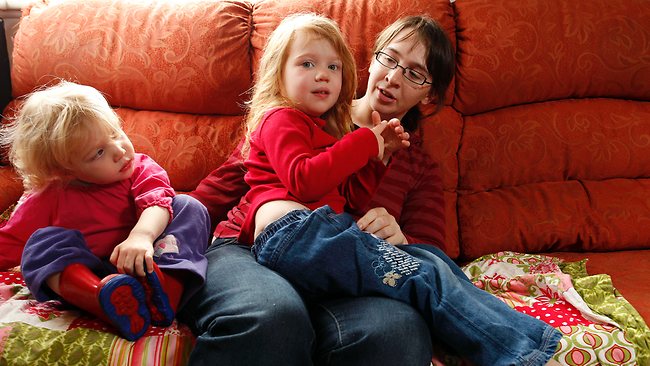Dr Elspeth McInnes
BA Hons 1 Flinders University of SA, PhD Flinders University of SA
In this presentation I want to talk about my research insights which go to the drivers of poverty in Australian society and their relationship to gender. Before I do that I want to briefly scope the ways in which poverty is talked about by policymakers, researchers and community sector service providers. In Australia poverty is normally defined either in relation to the Henderson poverty line – a basket of goods approach, in statistical terms as the half point of the Australian median wage, or in terms of deprivation of access to reasonable social standards – such as the ability to afford a week holiday away from home once a year. This last approach is the measure which gives greatest insight into what people go without when they live in poverty. Under all measures, single parent families consistently present as the family type at most risk of experiencing poverty.
It is important to note here the immediate and longer-term impacts of poverty for children. Low income families struggle to meet the costs of housing and utilities, food, health, education, clothing and recreation. For a child, these struggles translate into frequent housing changes, including homelessness. Social isolation from peers and wider family connections comes with no money for recreation or leisure. Living without gas or electricity and thus the capacity to control temperatures, store and cook food and maintain hygiene means a diet of junk food, dirty clothes and bedding, living with candles and shivering in the dark. These experiences leave developmental markers of chronic stress, poor nutrition and poor social skills, setting children on a trajectory of enduring disadvantage.
When we look to recent policies to address poverty in single parent families, such as the ‘Incentive to Work’ Act which, from January 1 this year, pushed all single parents with children aged 8 onto the lower Newstart Allowance, leaving them between $60 and $100 worse off per week; both the Coalition under Howard and the Labor Party under Gillard, have opted for a punitive behaviourist approach which first nominates the one-liner that ‘a job is the best form of welfare’, then reduces the capacity for economic survival by reducing income support payments and decreasing the economic rewards of paid work using increased clawback against earnings.
The policy premise is apparently that increasing family poverty creates jobs. There is no empirical evidence offered for such a claim, but media spin has steadily replaced informed critical scrutiny and single mothers are seen as an unpopular group which can be attacked without much political consequence. The title ‘Incentive to Work’ implies that single parents who are not in the paid workforce lack incentive to work. Reducing the rewards they get from working by reducing income support at lower earnings thresholds is a strange version of an ‘incentive’ worthy of Alice in Wonderland. There is no recognition that reducing parental availability to support children by requiring parents to seek work, will itself increase risks of adverse outcomes for children left home alone. In summary, the current policy approaches are dismal, punitive and ineffective. In the hope of expanding understanding of the drivers of poverty, and thus the prospect of effective policy reform, it is important to recognise the impact of gender. In this respect I plan to cover three key social institutions – families and unpaid care; labour markets and paid work; and family violence.
What I have to say draws on my research which compared the transition to single parent households for mothers with and without violent partners (McInnes 2001). The issue of violence did not appear when I first scoped this research, which aimed to examine the education and work behaviours of single parents following relationship breakdown. I had planned to interview both single fathers and single mothers. The first discovery for me was that mothers and fathers came into single parenthood along very different pathways. Where women in the study carried primary and continuing responsibility for their children both during and after the relationship, men assumed the primary carer role only when the mother was unable to do so for some reason – either through death, disability or a legal judgement. Their engagement as non-resident parents was optional. My second major insight was that, for those women who had to contend with violence and abuse victimization, the violence and abuse dominated and shaped their opportunities and choices. I will come back to this later. Now I wish to turn to my first point of gender analysis – unpaid care work in families.
Time use research in Australia consistently shows that women do vastly more housework and care for dependent others – children and adults – compared to men. Whilst being pregnant and giving birth forces women to stop paid work for a time, they usually remain the primary carer as the children grow, and fit their paid work around the care needs of family members. Such unpaid care work is not costed in GDP and remains invisible in the national accounts. A paid child care worker counts as part of the formal economy, but the intensive one to one 24 hour attendance of parenting infants or caring for a person with a serious chronic illness or disability, does not. An example of this was the basis of the 2006 formula changes for the child support system. Policymakers calculated that children became more expensive as they grew and required more services and possessions. This calculation was only possible by excluding the unpaid care work of parents and the opportunity costs to earnings of taking time out from the paid workforce to provide unpaid care. Anyone who purchases formal child care knows that babies are much more expensive to care for than older children because they require a much higher level of active attendance. Child support policy makers only counted expenditure on children, and excluded labour inputs.
Women’s ‘traditional’ gender role of unpaid care provider takes a high toll on their availability for paid work. When loss of experience, missed training opportunities and disrupted professional networks are factored in, the economic toll climbs even higher.
So this is a first point, gender shapes poverty experiences because it is women who perform the bulk of unpaid care work and therefore women who lose income opportunities whilst providing that care. Care work in families is fundamental to human survival, but should women be expected to continue to sacrifice their economic survival for love? The latest report by the Australian Human Rights Commission, ‘Investing in Care: Recognising and Valuing Those who care’ (2013) confirms the economic plight of unpaid carers and the gendered profile of mainly women carers. The report identifies the risks of unpaid care as a pathway to lifelong poverty, as women forgo earnings, savings and career development opportunities. When women have access to the support of a male breadwinner, their lack of personal income is concealed by the partnership earnings. When relationships end, or the breadwinner becomes sick or disabled, women’s limited earnings are exposed. So the social institution of women’s unpaid care work in families is a key driver of women’s poverty.
This brings me to the second relevant institution which drives women’s poverty – the labour market. Having noted that unpaid care work keeps many women out of paid work, there is another problem with the gendered profile of the distribution of jobs and earnings. Despite women’s rising participation and success in higher education, men still get higher pay for the same job and have access to a much wider range of jobs with better conditions, relative to women. Women employees are largely clustered in the services sector, dominating human services such as health and education, along with retail and hospitality. Many of these jobs are poorly paid, insecure, with minimal opportunities for advancement. The Fair Work Australia inquiry into community sector pay and conditions highlighted that women in the sector were paid much less than male workers doing similar roles in the public sector. There is an under-representation of women in corporate boardrooms and in the Parliaments and local councils of Australia. As the Australian Defence Forces sex scandals have illustrated, women face entrenched cultures of sexist abuse when they seek to participate in male dominated workforces. So when women get into the paid workforce they face having less choice of jobs, lower pay, fewer advancement and training opportunities and less secure employment compared to their male counterparts. This flows through to lower superannuation savings, which reflect the lower levels of earnings and reduced time in the paid workforce. The gendered labour market is thus another key institution which systematically reproduces women’s poverty. Women with unpaid care responsibilities need to find, and often pay for, alternative care whilst they are at work, imposing an additional cost on their workforce participation. In parenting mediation sessions for separated parents, mothers commonly report that contact hours are worked out around the father’s work demands. The gendered assumption that mother’s work is less important than father’s work, continues to play out even after the relationship has ended.
Relationships end for many reasons. We know that marriages are more durable than de facto relationships. This makes sense because the couple have actively committed themselves to a life together, rather than simply cohabiting. We know that wealthier couples are more likely to be married and stay together than those on lower incomes. Research also identifies higher rates of domestic violence in lower income families. Australian statistics indicate that around one in three women have experienced domestic violence (Mouzos & Makkai 2004). Mothers whose relationships have ended are more than twice as likely to have experienced violence compared to other mothers (Butterworth 2004). These statistics illustrate the third institutional driver of women’s poverty – male violence against women. There are a number of theories about the relationship between interpersonal violence and poverty which I was forced to consider in my research as half the sample of single mothers I interviewed disclosed they had left a physically abusive relationship. Half of these again reported they had also been abused as children, showing the intergenerational impacts of family violence.
One theory about the relationship between violence and poverty is cultural and goes along the lines that ‘the poor are like that, that’s what they do’. A second theory is that people on low incomes come under greater scrutiny and surveillance so they are more likely to show up in official crime statistics compared to wealthier families. A third theory is that people who are financially stressed and disempowered are more likely to resort to violence to deal with their stress. A fourth theory proposes that the use of violence is a strategy to maintain dominance and control over others. When considering these theories against the reported experiences of the single mothers, only the last option seemed to fit. Some of the women had been married to very wealthy violent men, but their access to wealth depended entirely on staying in the relationship. Some of the violent men had used violence in order to achieve their wealth. For example, one ex-partner was a bikie and drug-dealer. The surveillance theory was also undermined by the fact that many of the women never reported the abuse. The dominant theme of the women’s experience was that of ‘walking on eggshells’ in a bid to prevent an eruption of violence, trying to do everything perfectly so as not to upset him. The stress associated with violence was a dominant concern of the victim who desperately tried to avoid another attack, but not a necessary part of the perpetrator’s experience. Another dominant theme of these women was their lack of access to the financial proceeds of the partnership. As one mother noted “I value my life more than anything. He made it clear he would kill me if I tried to apply for a property settlement.” This is consistent with the findings of an AIFS study (Sheehan & Smyth 2000), which identified that women were much less likely to gain any financial settlement from the partnership where violence had been a factor.
The research process made it clear to me that there certainly is a relationship between poverty and violence, however it is the victim who is always impoverished. The perpetrator may be wealthy or poor, but the experience of violence victimization created or increased poverty for the victim. Violence forced victims to leave their relationships and any financial support, abandon possessions, abandon property interests, to spend money replacing the household they had lost, to meet legal and health bills arising from the violence and to become the only full-time parent for children who themselves were traumatized by violence. Both children and adults exposed to violence face risks of traumatization, anxiety and depression – conditions which can derail people from success in education and in paid work. The disabling impacts of exposures to violence sharply escalate the risks of being unable to successfully gain and sustain well-paid employment. It is these future-cascading impacts which generate the observed links between poverty and violence. The damage wrought by exposures to violence increases with the duration of exposure, severity of violence and frequency of attack. The younger the age of exposure, the greater the risk of developmental traumatization where the young child adapts to survival in a dangerous and violent environment. Such children can face lifelong problems with social relationships, learning and earning, raising the risks of chronic intergenerational poverty. The family law system’s practices which privilege children spending time with parents, ahead of children’s safety when there are issues of violence, create a context of ongoing harm to the children and distress to the mother. When we consider that one in three Australian women has been subject to domestic violence (Mouzos & Makkai 2004) and around one in two single mothers (McInnes 2001; Butterworth 2004) have experienced domestic violence, it is clear that violence is a significant contributor to women’s poverty.
To recap – current approaches to poverty fail to take account of the gendered factors which reproduce women’s poverty. Women’s unpaid care work is simply an expected dimension of family life. Women’s lower pay and more limited job and career opportunities systematically reproduce men’s financial privilege, and men’s violence to women can work to enrich the perpetrator and to further reduce women’s health and earning capacity. These drivers of women’s poverty need to be comprehensively addressed by policymakers instead of the current approach of blaming and punishing individual women for being poor.
As the Australian Human Rights Commission report recommends, we need to be investing in supports for the unpaid care workforce. These supports need to be directed towards the long-term financial security of unpaid carers, their workforce participation and their access to alternative care, training and education. For example, people who are not in the paid workforce due to parenting or other care demands could receive payments into their superannuation accounts in part recognition of the economic savings their unpaid work creates. The January 2013 welfare changes forcing single parents onto lower Newstart payments have the ridiculous practical outcome of imposing heavy fines on people who have part-time work. Far from creating work incentives, these changes impose penalties on all parents whose children turn 8, and the biggest penalties are imposed on those who have some work. A sensible policy, aimed at supporting workforce participation, would provide parents in part-time work with increased benefits from working, allowing them to gain a better standard of living from paid work. Policymakers could also consider explicit links between unpaid care work and support for training and education. Scholarships and bonuses to meet the costs of study would send a clear message to unpaid carers that their time out of the paid workforce could also be used to support their re-skilling for eventual re-entry.
Considering the gendered labour market, a lot more could be done to support equal work opportunities and equal pay conditions. There needs to be an improvement in the obligations placed on employers to provide family-friendly flexibility and to monitor equal pay outcomes. Employers who pay workers different rates for the same job need to be held accountable and given incentives to comply with equal pay law. Harassing and sexually discriminating employers should face heavy sanctions for such practices and be forced to compensate the workers they have harmed. There is a need to address women’s access to diverse sectors of the economy and to explicitly recruit women into male dominated sectors. Jobs services providers have a role to play in broadening the types of work and training to which women are referred and in ensuring that the protections around participation requirements are actually implemented. For example the Financial Suitability Test which provides that single parents should not be forced to take jobs that provide a net income improvement of less than $25 per week is apparently never implemented according to jobseekers. Similarly domestic violence participation exemptions require that victims MUST be given a 16 week exemption from work participation requirements, yet very few victims of violence are actually offered such an exemption and are not even aware of its existence.
The issue of violence against women provides a continuing challenge across society. Sadly policy efforts are currently crashing into a declining recognition that violence is a gendered issue. The efforts of men’s rights groups have promoted the idea that men and women participate equally in violence. This claim flies in the face of the fact that it is women as victims which police see day in and day out and four out of five intimate partner homicides involve women as victims. Research comparing men’s and women’s experiences of domestic violence highlight four major differences – men are much less likely to say they are afraid of their partner, they typically do not have primary responsibility for dependent others, the violence stops completely at separation and they are much less likely to suffer serious injury or death (Bagshaw et al 2011) . In contrast women victims report high levels of fear, having to manage the needs of children and, for women, violence typically escalates at separation. Separation and the first year after separation are when women face the highest risk of being seriously injured or killed. Some commentators promote the idea that victims are equally responsible for violence if they do not end violent relationships. Such people typically have no insight into the issues of fear, being responsible for dependent others, having no money, no housing and no supports. Let’s be clear that blaming victims for the violence against them is a clear statement of support for perpetrators of violence. He too will blame his victim for making him hit her. Another major problem is that many states require police to report domestic violence incidents to child protection services when children are present. The child protection response commonly threatens mothers with loss of their children if they don’t leave the perpetrator. Of course when women do leave, the family law system often orders the children straight back to the care of the perpetrator. Sometimes child protection services also place the children with the perpetrator of the violence because ‘he is only violent to her because she provokes him and he is fine with the children’. Understandably victims of violence are becoming increasingly resistant to police involvement because they don’t want to lose care of their children. This would be easily addressed by having a policy approach which held the perpetrator to account and supported the safety of the victim and her children, rather than blaming her for living with a perpetrator. Other needed reforms include increased prosecutions of domestic assaults and for breaches of domestic violence orders, family law reforms to strengthen the investigations of alleged abuses by qualified forensic practitioners, along with financial compensation for violence in the relationship, as well as much greater access to emergency housing and other supports for women having to leave violence.
It is important to recognise that domestic violence is the primary organiser of victims’ options with regard to all aspects of their lives. In my research it became clear that questions of work or study for victims were subordinate to having to manage the threat of violence. Neurological research has identified that traumatic exposures interrupt learning. The brain focuses on survival – scanning the environment for threats, with every sense hyper vigilant to clues of danger. The blood flow to the cerebral cortex – the part of the brain linked to language and expression and executive function – actually decreases when threats are identified. Our survival under threat relies on being able to physically run away, hide from or fight off danger – not reading books about having conversations with people who want to kill you. When children grow up in contexts of ongoing threat, their brains develop to a permanent state of heightened vigilance, interfering with their learning and social relationships (Streeck-Fischer & van der Kolk 2000). Adult victims not only have to manage their own alarm reactions but also respond to their children’s heightened sensitivities to danger cues. Going into hiding, attending to legal proceedings, dealing with health problems and children’s needs become the day to day necessity which over-rides opportunities for paid work and study. Paid work presents risks if the perpetrator knows where she works. The need for more sick leave and the added stress of coping with constant threat means that victims can lose their jobs if they have managed to hold on to employment.
One common policy reaction to economic disadvantage is to point to education as the cure, but we need to take on board that learning is only accessible to both adults and children in a state of safety. Children and adults whose lives have been affected by violence need access to services which enable them to understand how trauma is affecting their lives, their personal trauma ‘triggers’ and ways to desensitise themselves to these triggers so they can actively engage with the wider world. Our current medical model restricts responses to medical specialists and drug therapy, whereas we really need trauma-informed practice to be a feature of all human services professionals such as social workers, educators and health practitioners. It is in the day to day interactions over time that change happens, rather than limiting therapy to a brief visit with a medical expert once every few months.
There is a need for many more services to support victims of violence. The women’s services sector is becoming de-gendered and defunded under the onslaught of managerialist policies which aim for generic services provision. Women fleeing violence face increasing difficulty in getting into emergency accommodation and they may be sharing with men who are homeless. Women with addictions, those with teenage children and those with mental illnesses can face exclusion from services which do not address those issues. It is important to note here that traumatization is causally linked both with mental illness and substance abuse. Thus far the compartmentalization of service delivery effectively compromises victims of violence by shuffling them drug and alcohol referrals, to mental illness referrals, to domestic violence referrals in a spiral of ineffective action.
In conclusion I argue that unless we explicitly understand gendered drivers of poverty we will continue, as a society, to miss giving attention to the structural issues creating women’s poverty. Men of course also contend with poverty, but their drivers go more to inability to access education and paid work. In many cases men living with entrenched poverty can also point back to men’s violence in their childhoods leaving them with separated parents, struggling to stay housed and fed.
REFERENCES
Bagshaw, D., Brown, T. , Wendt, S., Campbell, A., McInnes, E., Tinning, B., Batagol, B., Sifris, A., Tyson, D., Baker, J., Fernandez Arias, P. 2010 Family Violence and Family Law in Australia: The Experiences and Views of Children and Adults from Families who Separated Post-1995 and Post-2006, Attorney-General’s Department, Canberra.
Butterworth, P. 2004 ‘Lone Mothers’ experience of physical and Sexual Violence: Association with Psychiatric Disorders,’ British Journal of Psychiatry, 184, pp. 21-27.
McInnes, E., (2001) ‘Public Policy and Private Lives: Single Mothers, Social Policy and Gendered Violence’, Thesis Collection, Flinders University of SA. http://www.ncsmc.org.au/phd
Mouzos, J. and Makkai , T., (2004) ‘Women’s Experiences of Male Violence’, Research and Public Policy Series No. 56, Australian Institute of Criminology, Canberra.
Sheehan, G., and Smyth, B., (2000) ‘Spousal Violence and Post-Separation Financial Outcomes’, Australian Journal of Family Law, 14 (2): 102-118.
Streeck-Fischer, Andrew., and Van der Kolk, Bessell. (2000). Down will come baby, cradle and all: Diagnostic and Therapeutic Implications of trauma on child development. Australian and New Zealand Journal of Psychiatry, 34 (6): 903-18.






